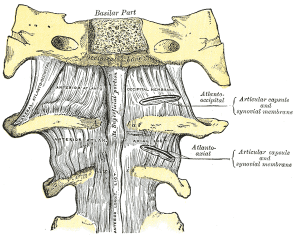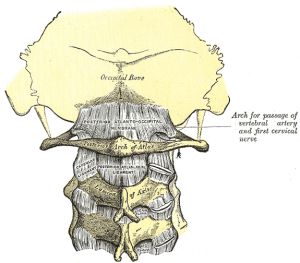Atlanto-axial joint: Difference between revisions
(Created page with "<div class="editorbox"> '''Original Editor '''- Rachael Lowe '''Lead Editors''' </div> == Description == [[Image:Atlanto-occipital joint anteri...") |
No edit summary |
||
| Line 21: | Line 21: | ||
== Capsule<br> == | == Capsule<br> == | ||
The atlantoaxial articular capsules are thick and loose, and connect the margins of the lateral masses of the atlas with those of the posterior articular surfaces of the axis. | The atlantoaxial articular capsules are thick and loose, and connect the margins of the lateral masses of the atlas with those of the posterior articular surfaces of the axis. | ||
Each is strengthened at its posterior and medial part by an accessory ligament, which is attached below to the body of the axis near the base of the odontoid process, and above to the lateral mass of the atlas near the transverse ligament.<br> | Each is strengthened at its posterior and medial part by an accessory ligament, which is attached below to the body of the axis near the base of the odontoid process, and above to the lateral mass of the atlas near the transverse ligament.<br> | ||
== Ligaments == | == Ligaments == | ||
The ligaments connecting these bones are: | The ligaments connecting these bones are: | ||
*Articular capsules | *Articular capsules | ||
*[[Anterior atlantoaxial ligament]] | *[[Anterior atlantoaxial ligament]] | ||
*[[Posterior atlantoaxial ligament]] | *[[Posterior atlantoaxial ligament]] | ||
*[[Transverse ligament of the atlas]] | *[[Transverse ligament of the atlas]] | ||
The atlantoaxial joint in common terminology is actually a composition of three: two lateral and one median atlantoaxial joints. Because of its proximity to the brain stem and importance in stabilization, fracture or injury at this level can be catastrophic. Common trauma and pathologies include (but are not limited to): | The atlantoaxial joint in common terminology is actually a composition of three: two lateral and one median atlantoaxial joints. Because of its proximity to the brain stem and importance in stabilization, fracture or injury at this level can be catastrophic. Common trauma and pathologies include (but are not limited to): | ||
*The Dens: significant depression on the skull can push the dens into the brainstem, causing death. The dens itself is vulnerable to fracture due to trauma or ossification. | *The Dens: significant depression on the skull can push the dens into the brainstem, causing death. The dens itself is vulnerable to fracture due to trauma or ossification. | ||
*Transverse ligament: Should the transverse ligament of the atlas fail due to trauma or disease, the dens is no longer anchored and can travel up the cervical spine, causing paralysis. If it reaches the medulla death can result. Alar ligaments: stress or trauma can stretch the weaker alar ligaments, causing an increase in range of motion of approximately 30%. | *Transverse ligament: Should the transverse ligament of the atlas fail due to trauma or disease, the dens is no longer anchored and can travel up the cervical spine, causing paralysis. If it reaches the medulla death can result. Alar ligaments: stress or trauma can stretch the weaker alar ligaments, causing an increase in range of motion of approximately 30%. | ||
Posterior Atlanto-Occipital Membrane: genetic traits can sometimes result in ossification, turning the groove into an foramen. | Posterior Atlanto-Occipital Membrane: genetic traits can sometimes result in ossification, turning the groove into an foramen. | ||
== Muscles == | == Muscles == | ||
| Line 60: | Line 60: | ||
== Open Packed Position == | == Open Packed Position == | ||
== Other Important Information | == Other Important Information<br> == | ||
== Resources == | == Resources == | ||
| Line 71: | Line 66: | ||
== Recent Related Research (from [http://www.ncbi.nlm.nih.gov/pubmed/ Pubmed]) == | == Recent Related Research (from [http://www.ncbi.nlm.nih.gov/pubmed/ Pubmed]) == | ||
<div class="researchbox"> | <div class="researchbox"> | ||
<rss>http://www.ncbi.nlm.nih.gov/entrez/eutils/erss.cgi?rss_guid= | <rss>http://www.ncbi.nlm.nih.gov/entrez/eutils/erss.cgi?rss_guid=1V5bX9N3xU3wSKpCBNzE17WYEkiTc9OgR-xQZJbLfXl9EV8Ym7|charset=UTF-8|short|max=10</rss> | ||
</div> | </div> | ||
== References == | == References == | ||
Revision as of 16:24, 18 January 2014
Original Editor - Rachael Lowe
Lead Editors
Description[edit | edit source]
The atlanto-axial joint is a joint in the upper part of the neck between the first and second cervical vertebrae; the atlas and axis.
Articulating Surfaces[edit | edit source]
There are two atlanto-axial joints: medial and lateral:
The median atlantoaxial joint is sometimes considered a double joint:
- one between the posterior surface of the anterior arch of atlas and the front of the odontoid process
- one between the anterior surface of the ligament and the back of the odontoid process
The lateral atlantoaxial joint involves the lateral mass of atlas and axis.
Between the articular processes of the two bones there is on either side an arthrodial or gliding joint.
Capsule
[edit | edit source]
The atlantoaxial articular capsules are thick and loose, and connect the margins of the lateral masses of the atlas with those of the posterior articular surfaces of the axis.
Each is strengthened at its posterior and medial part by an accessory ligament, which is attached below to the body of the axis near the base of the odontoid process, and above to the lateral mass of the atlas near the transverse ligament.
Ligaments[edit | edit source]
The ligaments connecting these bones are:
- Articular capsules
- Anterior atlantoaxial ligament
- Posterior atlantoaxial ligament
- Transverse ligament of the atlas
The atlantoaxial joint in common terminology is actually a composition of three: two lateral and one median atlantoaxial joints. Because of its proximity to the brain stem and importance in stabilization, fracture or injury at this level can be catastrophic. Common trauma and pathologies include (but are not limited to):
- The Dens: significant depression on the skull can push the dens into the brainstem, causing death. The dens itself is vulnerable to fracture due to trauma or ossification.
- Transverse ligament: Should the transverse ligament of the atlas fail due to trauma or disease, the dens is no longer anchored and can travel up the cervical spine, causing paralysis. If it reaches the medulla death can result. Alar ligaments: stress or trauma can stretch the weaker alar ligaments, causing an increase in range of motion of approximately 30%.
Posterior Atlanto-Occipital Membrane: genetic traits can sometimes result in ossification, turning the groove into an foramen.
Muscles[edit | edit source]
Motions Available[edit | edit source]
The movements permitted in this joint are movements of the head on neck, consisting of:
- flexion and extension around the mediolateral axis, which give rise to the ordinary forward and backward nodding of the head.
- slight lateral motion, lateroflexion, to one or other side around the anteroposterior axis.
Flexion is produced mainly by the action of the rectus capitis anterior. Limited by tectoral membrane.
Extension by the rectus capitis posterior major and minor, assisted by the obliqus capitis superior, the semispinalis capitis, splenius capitis, sternocleidomastoid, and upper fibers of the trapezius.
The rectus capitis lateralis are concerned in the lateral flexion, assisted by the trapezius, splenius capitis, semispinalis capitis, and the sternocleidomastoid of the same side, all acting together.
Closed Packed Position[edit | edit source]
Open Packed Position[edit | edit source]
Other Important Information
[edit | edit source]
Resources[edit | edit source]
Recent Related Research (from Pubmed)[edit | edit source]
Failed to load RSS feed from http://www.ncbi.nlm.nih.gov/entrez/eutils/erss.cgi?rss_guid=1V5bX9N3xU3wSKpCBNzE17WYEkiTc9OgR-xQZJbLfXl9EV8Ym7|charset=UTF-8|short|max=10: Error parsing XML for RSS
References[edit | edit source]
References will automatically be added here, see adding references tutorial.








